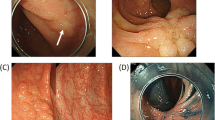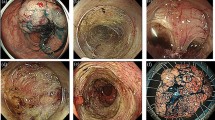Abstract
Objective
Endoscopic submucosal dissection (ESD) allows for en bloc resection of superficial gastrointestinal neoplasms; however, US experience has been limited. We aimed to evaluate our clinical outcomes in colorectal ESD.
Design
This prospective study included consecutive patients undergoing colorectal ESD at a major US center. Demographics, lesion and technical characteristics, outcomes, adverse events, and pathological diagnoses were recorded. Factors affecting resection outcomes and procedure time were evaluated.
Results
77 patients who underwent colorectal ESD were analyzed. Mean colorectal lesion diameter was 49.4 mm. Mean procedure time was 104.7 min, and 97.4% of patients were discharged home on the same day. En bloc, complete, and curative resection was achieved in 97.4%, 97.4%, and 93.5% of colorectal ESD cases. Microperforation and delayed bleeding rates were 1.3% and 3.9%. On univariable analysis, the presence of tattoo adversely affected en bloc resection (p = 0.002), complete resection (p = 0.002), and curative resection (p = 0.008). Prior EMR attempts adversely affected en bloc resection (p = 0.028), complete resection (p = 0.028), and procedure time (p = 0.008). On multivariable analysis, the presence of tattoo predicted failure to achieve curative resection (OR 0.13; 95% CI 0.02–0.98; p = 0.048). Lesion size > 50 mm (OR 3.89; 95% CI 1.13–13.41; p = 0.031), presence of tattoo (OR 9.38; 95% CI 1.05–83.83; p = 0.045), and prior EMR attempts (OR 7.13; 95% CI 1.76–28.90; p = 0.006) predicted procedure time ≥ 90 min. A scoring system was created to predict prolonged ESD procedure time and was externally validated, with AUC 0.78 (95% CI 0.73–0.83).
Conclusion
This study demonstrates the effects of multiple risk factors on resection outcomes and procedure time in colorectal ESD. Tattoo placement and attempted EMR should be avoided for lesions being considered for ESD.


Similar content being viewed by others
Abbreviations
- ANOVA:
-
Analysis of variance
- AUROC:
-
Area under the receiver operating characteristics curve
- CI:
-
Confidence interval
- EMR:
-
Endoscopic mucosal resection
- ESD:
-
Endoscopic submucosal dissection
- EUS:
-
Endoscopic ultrasound
- LST:
-
Laterally spreading tumor
- LST-G:
-
Laterally spreading tumor, granular type
- LST-G (mixed):
-
Laterally spreading tumor, granular type, nodular mixed type
- LST-G (uni):
-
Laterally spreading tumor, granular type, homogeneous type
- LST-NG:
-
Laterally spreading tumor, non-granular type
- LST-NG (FE):
-
Laterally spreading tumor, non-granular type, flat-elevated type
- LST-NG (PD):
-
Laterally spreading tumor, non-granular type, pseudo-depressed type
- NBI:
-
Narrow band imaging
- SD:
-
Standard deviation
References
Akintoye E, Kumar N, Aihara H et al (2016) Colorectal endoscopic submucosal dissection: a systematic review and meta-analysis. Endosc Int Open 4:E1030–E1044
ASGE Technology Committee, Maple JT, Abu Dayyeh BK et al. (2015) Endoscopic submucosal dissection. Gastrointest Endosc 81:1311–1325
Pimentel-Nunes P, Dinis-Ribeiro M, Ponchon T et al (2015) Endoscopic submucosal dissection: European Society of Gastrointestinal Endoscopy (ESGE) Guideline. Endoscopy 47:829–854
Tanaka S, Kashida H, Saito Y et al (2015) JGES guidelines for colorectal endoscopic submucosal dissection/endoscopic mucosal resection. Dig Endosc 27:417–434
Oka S, Tanaka S, Saito Y et al (2015) Local recurrence after endoscopic resection for large colorectal neoplasia: a multicenter prospective study in Japan. Am J Gastroenterol 110:697–707
Chung IK, Lee JH, Lee SH et al (2009) Therapeutic outcomes in 1000 cases of endoscopic submucosal dissection for early gastric neoplasms: Korean ESD Study Group multicenter study. Gastrointest Endosc 69:1228–1235
Saito Y, Uraoka T, Yamaguchi Y et al (2010) A prospective, multicenter study of 1111 colorectal endoscopic submucosal dissections (with video). Gastrointest Endosc 72:1217–1225
Lee EJ, Lee JB, Lee SH et al (2013) Endoscopic submucosal dissection for colorectal tumors—1,000 colorectal ESD cases: one specialized institute’s experiences. Surg Endosc 27:31–39
Rex DK, Hassan CC, Dewitt JM (2017) Colorectal endoscopic submucosal dissection in the United States: Why do we hear so much about it and do so little of it? Gastrointest Endosc 85:554–558
Horie H, Togashi K, Kawamura YJ et al (2008) Colonoscopic stigmata of 1 mm or deeper submucosal invasion in colorectal cancer. Dis Colon Rectum 51:1529–1534
Tanaka S, Oka S, Kaneko I et al (2007) Endoscopic submucosal dissection for colorectal neoplasia: possibility of standardization. Gastrointest Endosc 66:100–107
Fujishiro M, Yahagi N, Nakamura M et al (2006) Endoscopic submucosal dissection for rectal epithelial neoplasia. Endoscopy 38:493–497
Hayashi Y, Miura Y, Yamamoto H (2015) Pocket-creation method for the safe, reliable, and efficient endoscopic submucosal dissection of colorectal lateral spreading tumors. Dig Endosc 27:534–535
Lambert R (2003) The Paris endoscopic classification of superficial neoplastic lesions: esophagus, stomach, and colon: November 30 to December 1, 2002. Gastrointest Endosc 58:S3–S43
Endoscopic Classification Review Group (2005) Update on the paris classification of superficial neoplastic lesions in the digestive tract. Endoscopy 37:570–578
Lambert R, Kudo SE, Vieth M et al (2009) Pragmatic classification of superficial neoplastic colorectal lesions. Gastrointest Endosc 70:1182–1199
Kudo S, Lambert R, Allen JI et al (2008) Nonpolypoid neoplastic lesions of the colorectal mucosa. Gastrointest Endosc 68:S3–S47
Hayashi N, Tanaka S, Nishiyama S et al (2014) Predictors of incomplete resection and perforation associated with endoscopic submucosal dissection for colorectal tumors. Gastrointest Endosc 79:427–435
Schlemper RJ, Riddell RH, Kato Y et al (2000) The Vienna classification of gastrointestinal epithelial neoplasia. Gut 47:251–255
Kitajima K, Fujimori T, Fujii S et al (2004) Correlations between lymph node metastasis and depth of submucosal invasion in submucosal invasive colorectal carcinoma: a Japanese collaborative study. J Gastroenterol 39:534–543
Uraoka T, Parra-Blanco A, Yahagi N (2013) Colorectal endoscopic submucosal dissection: is it suitable in western countries? J Gastroenterol Hepatol 28:406–414
Kim HG, Thosani N, Banerjee S et al (2015) Effect of prior biopsy sampling, tattoo placement, and snare sampling on endoscopic resection of large nonpedunculated colorectal lesions. Gastrointest Endosc 81:204–213
Tomiki Y, Ishiyama S, Sugimoto K et al (2011) Colorectal endoscopic submucosal dissection by using latex-band traction. Endoscopy 43(Suppl 2 UCTN):E250–E251
Nishizawa T, Uraoka T, Sagara S et al (2016) Endoscopic slipknot clip suturing method: an ex vivo feasibility study (with video). Gastrointest Endosc 83:447–450
Isomoto H, Nishiyama H, Yamaguchi N et al (2009) Clinicopathological factors associated with clinical outcomes of endoscopic submucosal dissection for colorectal epithelial neoplasms. Endoscopy 41:679–683
Park JC, Lee SK, Seo JH et al (2010) Predictive factors for local recurrence after endoscopic resection for early gastric cancer: long-term clinical outcome in a single-center experience. Surg Endosc 24:2842–2849
ASGE Technology Committee, Hwang JH, Konda V et al (2015) Endoscopic mucosal resection. Gastrointest Endosc 82:215–226
Author information
Authors and Affiliations
Contributions
PSG, MD (study concept and design, acquisition of data, analysis and interpretation of data, and drafting of manuscript). PJ, MD (analysis and interpretation of data, critical revision of manuscript). TRO, MD, PhD (analysis and interpretation of data). NT, MD, PhD (analysis and interpretation of data). KS, MD, PhD (analysis and interpretation of data). CCT, MD, MHES (study concept and design, analysis and interpretation of data, and critical revision of manuscript). HA, MD, PhD (study concept and design, acquisition of data, analysis and interpretation of data, critical revision of manuscript, and study supervision).
Corresponding author
Ethics declarations
Disclosures
Christopher C. Thompson: Boston Scientific (Consultant) and Olympus (Consultant, Research Support). Hiroyuki Aihara: Boston Scientific (Consultant), Olympus (Consultant), and Fujifilm Medical Systems (Consultant). Drs. Ge, Jirapinyo, Ohya, Tamai, and Sumiyama have no conflicts of interest or financial ties to disclose.
Additional information
Publisher’s Note
Springer Nature remains neutral with regard to jurisdictional claims in published maps and institutional affiliations.
About this article
Cite this article
Ge, P.S., Jirapinyo, P., Ohya, T.R. et al. Predicting outcomes in colorectal endoscopic submucosal dissection: a United States experience. Surg Endosc 33, 4016–4025 (2019). https://doi.org/10.1007/s00464-019-06691-4
Received:
Accepted:
Published:
Issue Date:
DOI: https://doi.org/10.1007/s00464-019-06691-4




